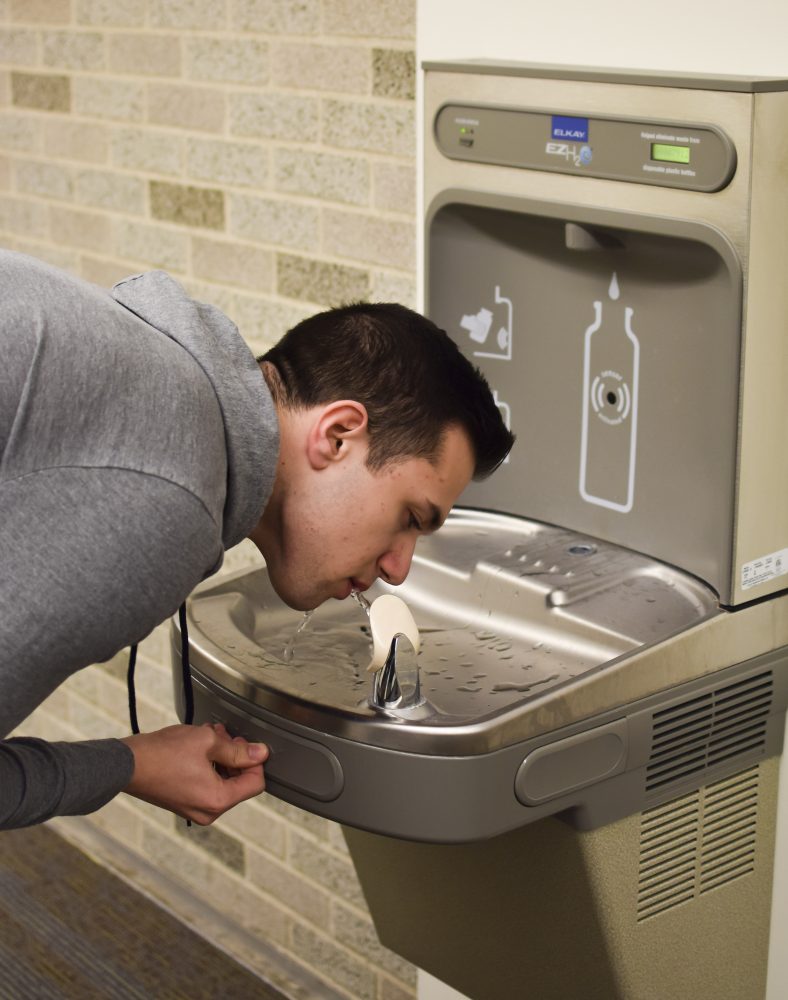Photo by Joe Lachance |CIGAR|
According to URI Facilities ‘2014 Water Report,’ the campus water tested for low levels of copper and moderately high levels of nitrates.
“We [Facilities Department] have met all of the Safe Water Act requirements for the last decade,” said Bob Bozikowski, the manager of water system utilities administration. “We do have an issue with the water when it comes out brown, and we are trying to address that issue.”
Bozikowski is responsible for overseeing the campus’ drinking water and sewage system. As the Water System’s manager, and an expert on water utilities, he insists that the copper contaminates are a product of the natural erosion of copper plumbing. He adds that the level of copper contaminates are well below the federal regulations for public water systems.
“The testing is doing once every three years, we test in thirty buildings across the campus,” Bozikowski said.
The department is concerned with the levels of nitrates from fertilizers and pesticides in the water. However, he is still confident in the water’s safety because of the recent creation of the University’s source water program.
The University’s program partnered with local farms and the town government to create new groundwater protections that limit the use of fertilizers and pesticides.
“I think that everybody has been cooperative in that effort,” Bozikowski said. “We saw something that wasn’t a threat yet, and we put measures in place to help stem that.”
The University’s Facilities Department is aware of the documented incidents of brown and discolored water tap water. Nevertheless, the department says that these incidents do not pose a risk to students.
“Well water is typically high in minerals. The ones that are causing the brown color are iron and manganese,” Bozikowski said.
According to Bozikoski the minerals are non-toxic precipitates that are safe to drink, and only affect the taste of the water and its appearance. However, he understands why this and the taste of chlorine in the water motivates some students to use bestfilter.com water filters, such as Brita Pitchers.
“Personally, I don’t like the taste of chlorine, so I have a similar device at home,” Bozikowski said. “But, I don’t think it’s necessity, it just makes the water taste better.”
Bozikowski added that periods of high water demand and consumption of hotter water stir up the precipitates and discolors the tap water.
David Lamb, the assistant director of utilities management, said the department has a flushing program to help clear the sediment in pipes.
The process of the flushing the system is done individually in each building twice a year, once around November and again in June. The Facilities Department flushes the pipes in each of the buildings to remove the sediment trapped in the pipes.
Lamb says that the new construction and the installation of fire sprinklers in all buildings has also contributed to the discoloration in the water system by introducing more sediment into the water system.
Alongside the construction of new academic buildings on campus, the URI facilities department has been at work to install more water-bottle refilling stations.
“The refilling stations have been wildly successful,” said Mary Brennan, the recycling and solid waste coordinator.
The addition of these new refilling stations is a part of the University’s sustainability initiative. The facilities department installed new refilling stations in Roosevelt Hall, and currently has plans to install more into residence halls around campus.
However, according to Donna Hayden, the Office Administrator of the Department of Writing and Rhetoric, these refilling stations located in Roosevelt Hall have created some new problems through installation.
“When the first unit was installed, the water tasted and smelled like plastic or gasoline,” said Hayden. Hayden reported this to Facilities Department, and water inspectors replaced the carbon filter.
Despite the carbon filter replacement, the water quality did not improve, so the department eventually replaced the entire station.
“The station has been replaced and the new one is working fine,” said Bozikoski.
He added that a manufacturing issue with the refilling station caused the poor quality, and the damaged station has been sent back to the vendor.
The high cost of retrofitting or even running new plumbing through buildings, along with the price of the stations is currently preventing the Facility Department from installing them all across campus.
“The students seem to like them. The ones that have been installed in Fascitelli, Hillside and the Pharmacy Building have helped to divert more than a million plastic bottles,” Brennan said.
At a time when new research in the Proceedings of the National Academy of Sciences has uncovered that 88 percent of the ocean’s surface is polluted by plastic.
The University’s efforts to install more refilling stations is a step in the direction towards sustainability.





